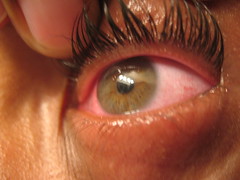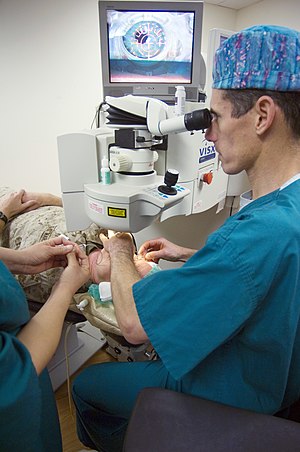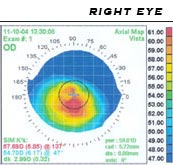If you are experiencing contact lens intolerance and are thinking about LASIK, STOP!

Before making this decision you need to know the truth: LASIK surgery has side effects and can lead to permanent disabling complications affecting your lifestyle permanently. Proceed with caution. According to recent studies between 10-40% of LASIK patients experience symptoms of complications. Symptoms include dry eyes, glare, halos and star bursting. Our own in-house experience, together with 10 other contact lens practices demonstrates the #1 reason patients seek LASIK is due to contact lens intolerance relating to dryness and blurry vision.
If you’ve had LASIK and are now experiencing problems, there is HOPE to get you back all day comfort with clear vision.
Prevention and Treatment of LASIK Problems
Dr. Irwin Azman maintains a contact lens specialty practice since 1977 with a special interest in the prevention and treatment of LASIK problems and restoration of vision and comfort lost as a result of refractive surgery: LASIK, PRK, RK, intacs, corneal transplant or keratoconus. Many of his patients travel from all parts of the United States and are referred by other eye care practitioners.
Unfortunately, most LASIK patients have some level of complication which has affected their lifestyle permanently. Some are out on total disability, while others suffer from depression. Symptoms range from dry eyes, burning eyes, glare, light sensitivity, ghost images, star bursts, double vision, loss of contrast sensitivity, fluctuation of vision, eye pain, and loss of sight.
Many of Dr. Azman’s patients have seen several other eye doctors before seeking his expertise and were told “nothing can be done” or that they needed a corneal transplant. Dr. Azman says “there is HOPE for the majority of these patients and to hold off on corneal surgery.”
Each case is different. Each patient will go thru 2-3 evaluations including: phone and in-person consultations, review of all previous eye records. Incorporating and using the latest technology to determine the exact problem and solution. Special tests range from: wavefront aberrometry, anterior and posterior OCT, tear scan, specular microscopy, meibography, tear osmolality, corneal evaluation, advanced refraction, refractive wavefront topography, and vital stainings.
Simple solutions can vary from a combination of dry eye treatment, prescribing of specialty soft lenses, to specialty post op LASIK rigid lenses. More complex solutions vary from the prescribing of customized reverse geometry lenses, customized piggy back lenses, hybrid lenses, to the most complex lens called post refractive surgery scleral lenses. If a patient has a highly irregular and distorted cornea, and experiences halos, star bursts, double vision, and decreased vision scleral lenses are usually the best option that can minimize/eliminate all the symptoms.
Unfortunately, most practitioners have very little experience, if any, while Dr. Azman has treated 100’s of patients.
With over 25 years of LASIK experience, Dr. Azman is one of the pioneers in preventing LASIK complications and treating those with Post LASIK / PRK / RK patient. Together with his knowledge and experience, Dr. Azman and his team employ the newest technologies in instrumentation and treatment modalities. Dr. Azman is able to prescribe each patient with a solution in resolving their Post LASIK / PRK / RK difficulties.








